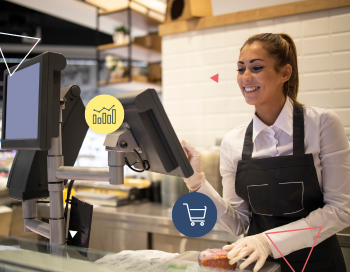“We quickly became comfortable with the Onix team’s expertise and the way they could easily explain what needed to be done and why.”
For more than 35 years, North American industrial railyards have relied on Railserve, Inc. for on-site, contract services that support customer production and new growth with innovative solutions. The Atlanta-based company uses its own locomotives and employees to safely move railcars within industrial, manufacturing and production plants.
Its parent company, the $8B Marmon Group (a Berkshire Hathaway company), provides the financial support that allows Railserve to invest in customer growth by providing the services the company needs. This includes switching, logistics, locomotive service, track maintenance and more. To do this, Railserve needs to be well staffed and managed — and using up-to-date processes and technologies.
As the largest provider of in-plant switching and associated services in North America, Railserve relies on its computer network to keep its 1,000+ employees at more than 70 rail operations connected with customers and each other. Its division offices needed to reliably communicate and collaborate at any time, from anywhere. The company also required a better data backup-and-disaster-recovery solution in the event of a failure.
Facing Infrastructure Challenges
The company is a leader in the use of technology, both to improve safety and efficiency for its customers. Railserve executives knew that the internal infrastructure must be able to support the company’s growth — and also be prepared for today’s security challenges. There were three key challenges to address.
Legacy hardware and software. The company’s aging hardware could not support newer versions of VMWare or Windows, and support for its aging Windows Operating Systems had been deprecated. This left the environment vulnerable to malware attacks.
Performance. The hardware didn’t provide adequate memory, CPU and I/O to accommodate growth. These gaps also contributed to latency issues.
Accounting system upgrade. Railserve needed to upgrade the existing version of MS Dynamics however was unable to do this with the existing infrastructure.
Launching a Transformation
Modern infrastructure was a must. It was time for a digital transformation. Railserve leadership researched solutions, weighed options and decided to pursue cloud migration rather than refreshing or purchasing new licenses for the current environment.
”We’ve always controlled overhead costs by maintaining a lean corporate support staff, but engage experts with a similar mindset where needed to be sure we are able to consistently support our operations and our customers,” explains Jerry Schadel, Railserve’s Director of Information Technology.
Onix, longtime Google Cloud Premier Partner stepped in to guide the company to determine the right path for this transformative journey.
When Google Cloud reps initially shared the Railserve story with Onix, it first appeared the team could do a simple “lift-and-shift” migration. This common migration technique replicates on-premise apps in the cloud without costly, time-consuming redesign. However, a pre-sale evaluation of the server environment at Railserve revealed that the job scope would be larger.
“We found all virtual machines needed to be upgraded,” said Mike Botte, sales engineer at Onix. “After looking further at Railserve’s server environment, we identified the opportunity to deploy Google Cloud Platform (GCP) so the company could upgrade all of its existing Windows software without needing to purchase and manage licensing from Microsoft.”
Deploying to the Cloud
That’s when the hard work began. Onix established site-to-site VPN connectivity between the three Railserve corporate locations and the GCP migration project. The team then implemented a new version of Windows virtual machines within GCP, and extended Active Directory to the cloud.
Once achieved, Onix migrated all data to the cloud and worked with Railserve’s Microsoft Dynamics vendor to implement the new accounting system and migrate its data.
Onix broke the project down into four, one-week engagements. This allowed adequate time between site migrations for data replication, connectivity baselining and application testing. The entire project, from initial planning to the final database migration was completed in approximately five weeks.
Because Railserve required remote connectivity for users traveling or working from home, Onix implemented a secure gateway solution using OpenVPN Access Server. This allowed users to establish a secure encrypted session to resources hosted in GCP without exposing unnecessary and insecure access ports to the internet. It limited the overall attack surface of the GCP environment — and provided Windows domain authentication and authorization.
Improving Backup Disaster Recovery
Company officials also wanted to increase backup reliability and gain improved disaster recovery in place.
“I needed sleep!” Schadel recalls. “The ever-changing and sophisticated attacks had me concerned about our ability to stay secure and if needed, recover timely.”
Google Cloud Platform gave the company a simple backup-and-disaster-recovery strategy that would save significant budget dollars compared with the point-in-time backup solution from a local IT company.
The Onix team provided point-in-time backups using Cloudberry backup software, and also offered disaster recovery through GCP image-based VM restoration. This feature gave Railserve instance recovery in any GCP region, something company leadership wanted and needed. The solution, however robust, wasn’t yet complete.
The approach did allow Railserve to spin up fully functional replicated servers in its GCP environment so they could begin processing requests in a timely fashion if a primary production server failed.
However the specified products couldn’t provide automatic snapshots, completing another Railserve request. To address this deficiency, Onix developed a process that automates the GCP snapshot feature with a sufficient retention period. This helps control the spend related to the growing snapshots in GCP.
Automated VM snapshots also gave Railserve a safeguard against ransomware-oriented threats and encryption vectors due to an inherent roll-back feature. This was a primary concern for Railserve.
“Railserve now has the ability to recover from a disaster within hours as opposed to days,” noted Joe Sallman, GCP Consultant at Onix. “Their restoration ability is so much more reliable now. People sleep better knowing their data and core infrastructure are secure.”
Leaving Managed Services to the Experts
From the start, Schadel says he quickly became comfortable with the Onix team’s expertise and the way they could easily explain what needed to be done and why.
“They paid close attention to our budget goals and worked with us to control costs,” he says, “If additional security costs arose, they quickly made me aware of it.”
Because of this two-way communication, Schadel enrolled Railserve in the Onix Managed Services Provider program. Designed to free up in-house IT time to focus on important tasks rather than reactive troubleshooting and extinguishing “fires,” the experienced Onix support team stepped in to oversee and maintain the Railserve cloud IT infrastructure.
Onix assumed 24/7/365 responsibility for monitoring, managing and resolving issues in the company’s cloud environment, allowing it to leave cloud concerns to the experts — and to focus instead on the business at hand, keeping trains on the rails.






